Mining Challenges and Supply Chain Management
VerifiedAdded on 2020/03/23
|15
|3075
|40
AI Summary
This assignment delves into the complex challenges confronting the mining industry, encompassing technical hurdles, risk mitigation strategies, and efficient supply chain management. It examines the role of transportation modes (ships and inland) in moving equipment from mining sites to remote locations, emphasizing the importance of timely delivery through supply chain optimization. Additionally, the report analyzes Australian customs issues and warehousing practices employed by mining companies for storing minerals and other products.
Contribute Materials
Your contribution can guide someone’s learning journey. Share your
documents today.
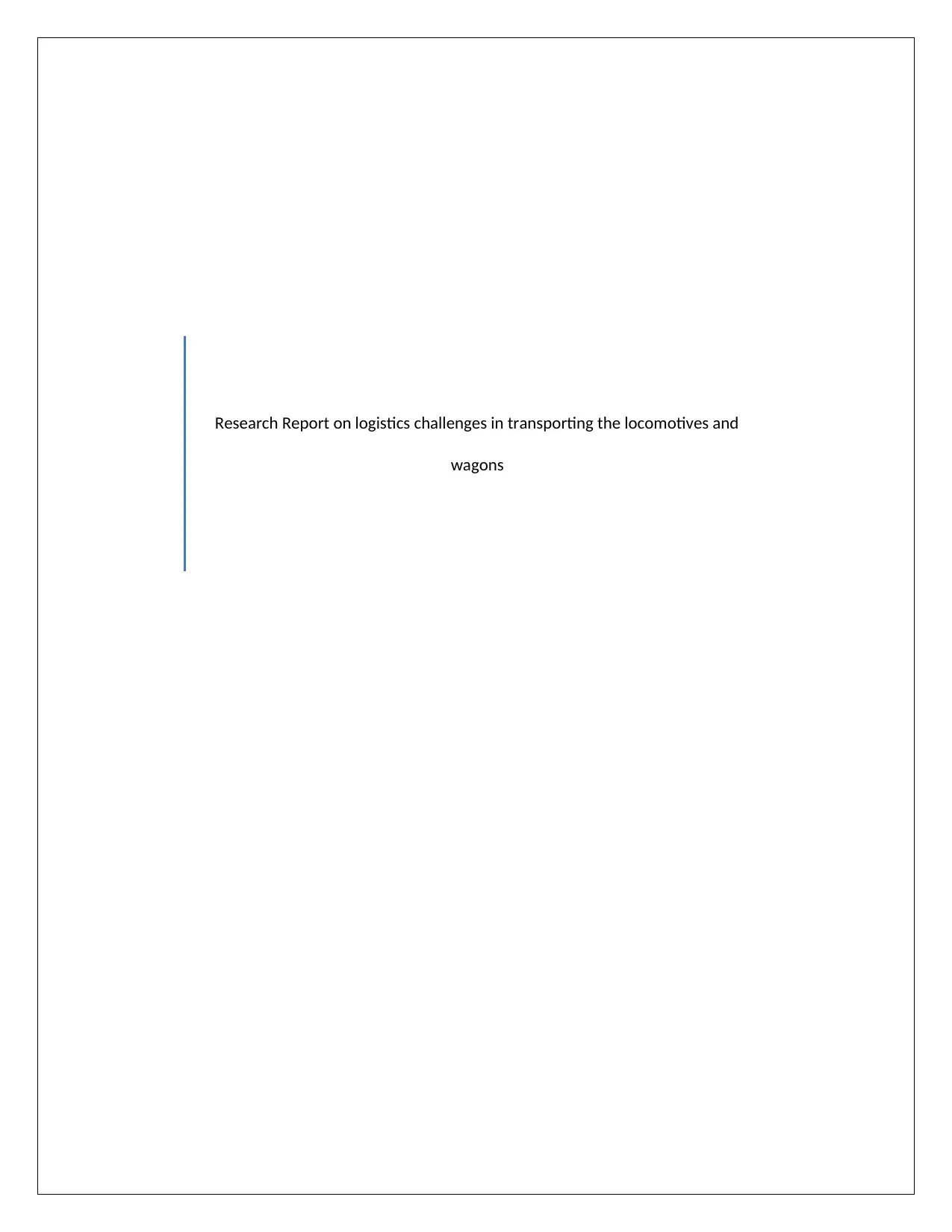
Research Report on logistics challenges in transporting the locomotives and
wagons
wagons
Secure Best Marks with AI Grader
Need help grading? Try our AI Grader for instant feedback on your assignments.
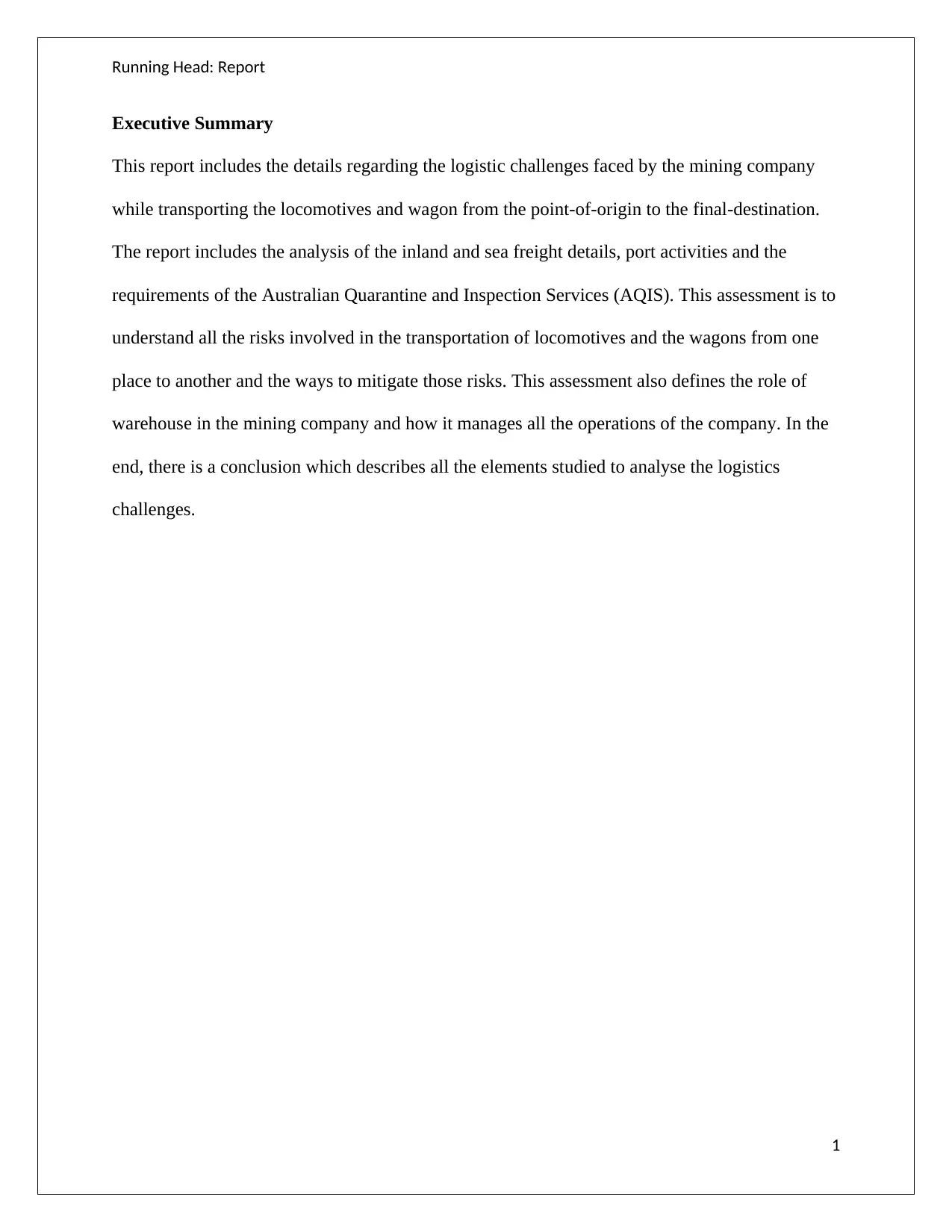
Running Head: Report
Executive Summary
This report includes the details regarding the logistic challenges faced by the mining company
while transporting the locomotives and wagon from the point-of-origin to the final-destination.
The report includes the analysis of the inland and sea freight details, port activities and the
requirements of the Australian Quarantine and Inspection Services (AQIS). This assessment is to
understand all the risks involved in the transportation of locomotives and the wagons from one
place to another and the ways to mitigate those risks. This assessment also defines the role of
warehouse in the mining company and how it manages all the operations of the company. In the
end, there is a conclusion which describes all the elements studied to analyse the logistics
challenges.
1
Executive Summary
This report includes the details regarding the logistic challenges faced by the mining company
while transporting the locomotives and wagon from the point-of-origin to the final-destination.
The report includes the analysis of the inland and sea freight details, port activities and the
requirements of the Australian Quarantine and Inspection Services (AQIS). This assessment is to
understand all the risks involved in the transportation of locomotives and the wagons from one
place to another and the ways to mitigate those risks. This assessment also defines the role of
warehouse in the mining company and how it manages all the operations of the company. In the
end, there is a conclusion which describes all the elements studied to analyse the logistics
challenges.
1
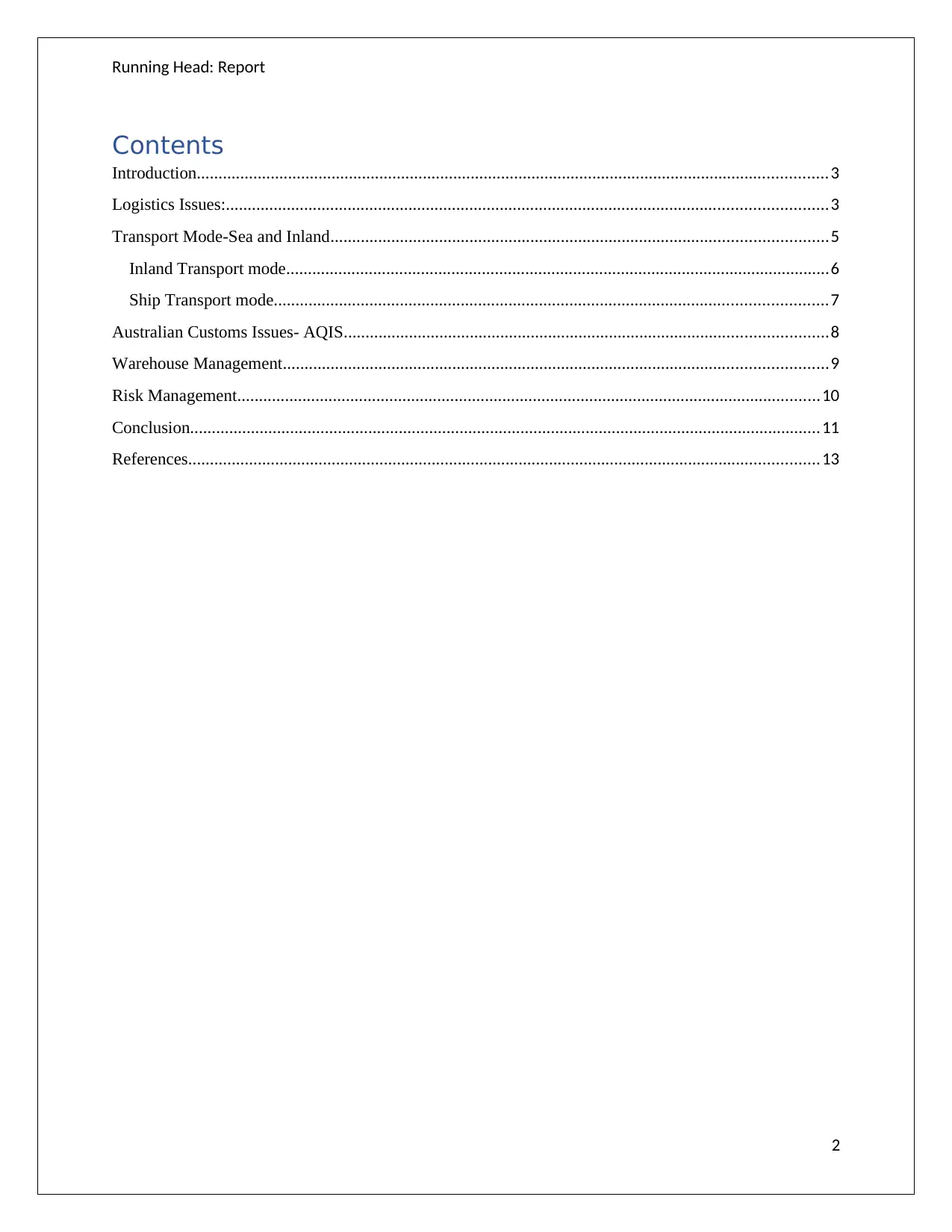
Running Head: Report
Contents
Introduction.................................................................................................................................................3
Logistics Issues:..........................................................................................................................................3
Transport Mode-Sea and Inland..................................................................................................................5
Inland Transport mode.............................................................................................................................6
Ship Transport mode...............................................................................................................................7
Australian Customs Issues- AQIS...............................................................................................................8
Warehouse Management.............................................................................................................................9
Risk Management......................................................................................................................................10
Conclusion.................................................................................................................................................11
References.................................................................................................................................................13
2
Contents
Introduction.................................................................................................................................................3
Logistics Issues:..........................................................................................................................................3
Transport Mode-Sea and Inland..................................................................................................................5
Inland Transport mode.............................................................................................................................6
Ship Transport mode...............................................................................................................................7
Australian Customs Issues- AQIS...............................................................................................................8
Warehouse Management.............................................................................................................................9
Risk Management......................................................................................................................................10
Conclusion.................................................................................................................................................11
References.................................................................................................................................................13
2
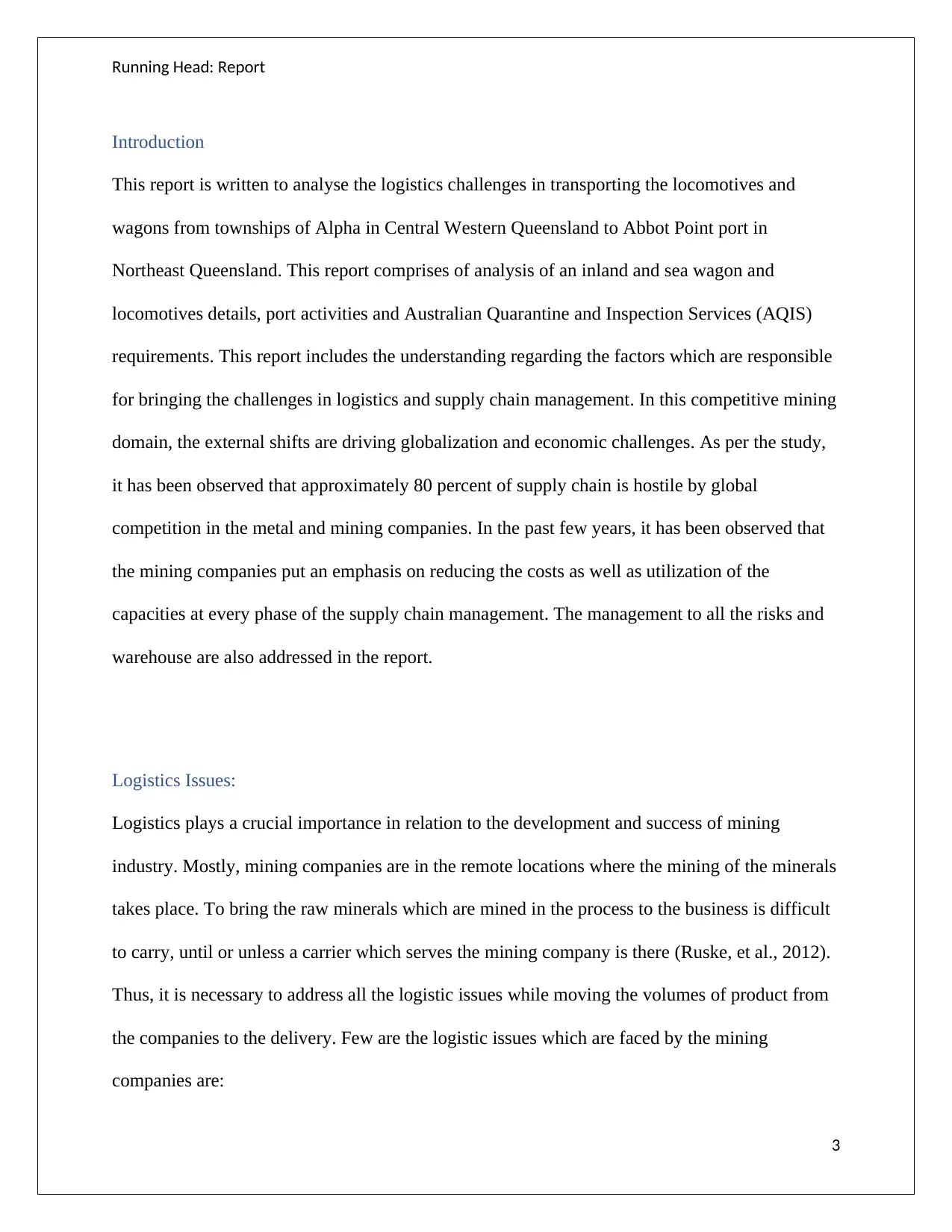
Running Head: Report
Introduction
This report is written to analyse the logistics challenges in transporting the locomotives and
wagons from townships of Alpha in Central Western Queensland to Abbot Point port in
Northeast Queensland. This report comprises of analysis of an inland and sea wagon and
locomotives details, port activities and Australian Quarantine and Inspection Services (AQIS)
requirements. This report includes the understanding regarding the factors which are responsible
for bringing the challenges in logistics and supply chain management. In this competitive mining
domain, the external shifts are driving globalization and economic challenges. As per the study,
it has been observed that approximately 80 percent of supply chain is hostile by global
competition in the metal and mining companies. In the past few years, it has been observed that
the mining companies put an emphasis on reducing the costs as well as utilization of the
capacities at every phase of the supply chain management. The management to all the risks and
warehouse are also addressed in the report.
Logistics Issues:
Logistics plays a crucial importance in relation to the development and success of mining
industry. Mostly, mining companies are in the remote locations where the mining of the minerals
takes place. To bring the raw minerals which are mined in the process to the business is difficult
to carry, until or unless a carrier which serves the mining company is there (Ruske, et al., 2012).
Thus, it is necessary to address all the logistic issues while moving the volumes of product from
the companies to the delivery. Few are the logistic issues which are faced by the mining
companies are:
3
Introduction
This report is written to analyse the logistics challenges in transporting the locomotives and
wagons from townships of Alpha in Central Western Queensland to Abbot Point port in
Northeast Queensland. This report comprises of analysis of an inland and sea wagon and
locomotives details, port activities and Australian Quarantine and Inspection Services (AQIS)
requirements. This report includes the understanding regarding the factors which are responsible
for bringing the challenges in logistics and supply chain management. In this competitive mining
domain, the external shifts are driving globalization and economic challenges. As per the study,
it has been observed that approximately 80 percent of supply chain is hostile by global
competition in the metal and mining companies. In the past few years, it has been observed that
the mining companies put an emphasis on reducing the costs as well as utilization of the
capacities at every phase of the supply chain management. The management to all the risks and
warehouse are also addressed in the report.
Logistics Issues:
Logistics plays a crucial importance in relation to the development and success of mining
industry. Mostly, mining companies are in the remote locations where the mining of the minerals
takes place. To bring the raw minerals which are mined in the process to the business is difficult
to carry, until or unless a carrier which serves the mining company is there (Ruske, et al., 2012).
Thus, it is necessary to address all the logistic issues while moving the volumes of product from
the companies to the delivery. Few are the logistic issues which are faced by the mining
companies are:
3
Secure Best Marks with AI Grader
Need help grading? Try our AI Grader for instant feedback on your assignments.
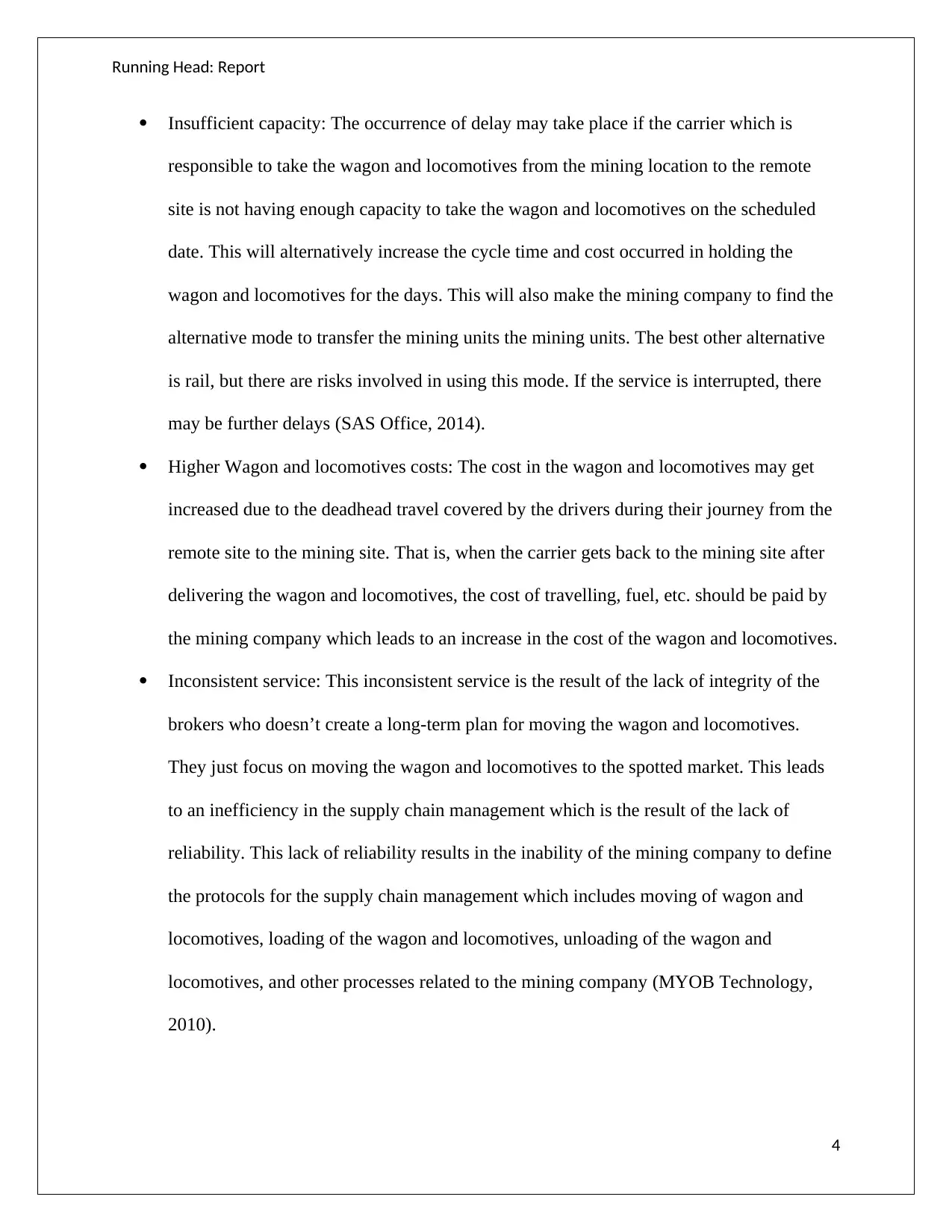
Running Head: Report
Insufficient capacity: The occurrence of delay may take place if the carrier which is
responsible to take the wagon and locomotives from the mining location to the remote
site is not having enough capacity to take the wagon and locomotives on the scheduled
date. This will alternatively increase the cycle time and cost occurred in holding the
wagon and locomotives for the days. This will also make the mining company to find the
alternative mode to transfer the mining units the mining units. The best other alternative
is rail, but there are risks involved in using this mode. If the service is interrupted, there
may be further delays (SAS Office, 2014).
Higher Wagon and locomotives costs: The cost in the wagon and locomotives may get
increased due to the deadhead travel covered by the drivers during their journey from the
remote site to the mining site. That is, when the carrier gets back to the mining site after
delivering the wagon and locomotives, the cost of travelling, fuel, etc. should be paid by
the mining company which leads to an increase in the cost of the wagon and locomotives.
Inconsistent service: This inconsistent service is the result of the lack of integrity of the
brokers who doesn’t create a long-term plan for moving the wagon and locomotives.
They just focus on moving the wagon and locomotives to the spotted market. This leads
to an inefficiency in the supply chain management which is the result of the lack of
reliability. This lack of reliability results in the inability of the mining company to define
the protocols for the supply chain management which includes moving of wagon and
locomotives, loading of the wagon and locomotives, unloading of the wagon and
locomotives, and other processes related to the mining company (MYOB Technology,
2010).
4
Insufficient capacity: The occurrence of delay may take place if the carrier which is
responsible to take the wagon and locomotives from the mining location to the remote
site is not having enough capacity to take the wagon and locomotives on the scheduled
date. This will alternatively increase the cycle time and cost occurred in holding the
wagon and locomotives for the days. This will also make the mining company to find the
alternative mode to transfer the mining units the mining units. The best other alternative
is rail, but there are risks involved in using this mode. If the service is interrupted, there
may be further delays (SAS Office, 2014).
Higher Wagon and locomotives costs: The cost in the wagon and locomotives may get
increased due to the deadhead travel covered by the drivers during their journey from the
remote site to the mining site. That is, when the carrier gets back to the mining site after
delivering the wagon and locomotives, the cost of travelling, fuel, etc. should be paid by
the mining company which leads to an increase in the cost of the wagon and locomotives.
Inconsistent service: This inconsistent service is the result of the lack of integrity of the
brokers who doesn’t create a long-term plan for moving the wagon and locomotives.
They just focus on moving the wagon and locomotives to the spotted market. This leads
to an inefficiency in the supply chain management which is the result of the lack of
reliability. This lack of reliability results in the inability of the mining company to define
the protocols for the supply chain management which includes moving of wagon and
locomotives, loading of the wagon and locomotives, unloading of the wagon and
locomotives, and other processes related to the mining company (MYOB Technology,
2010).
4
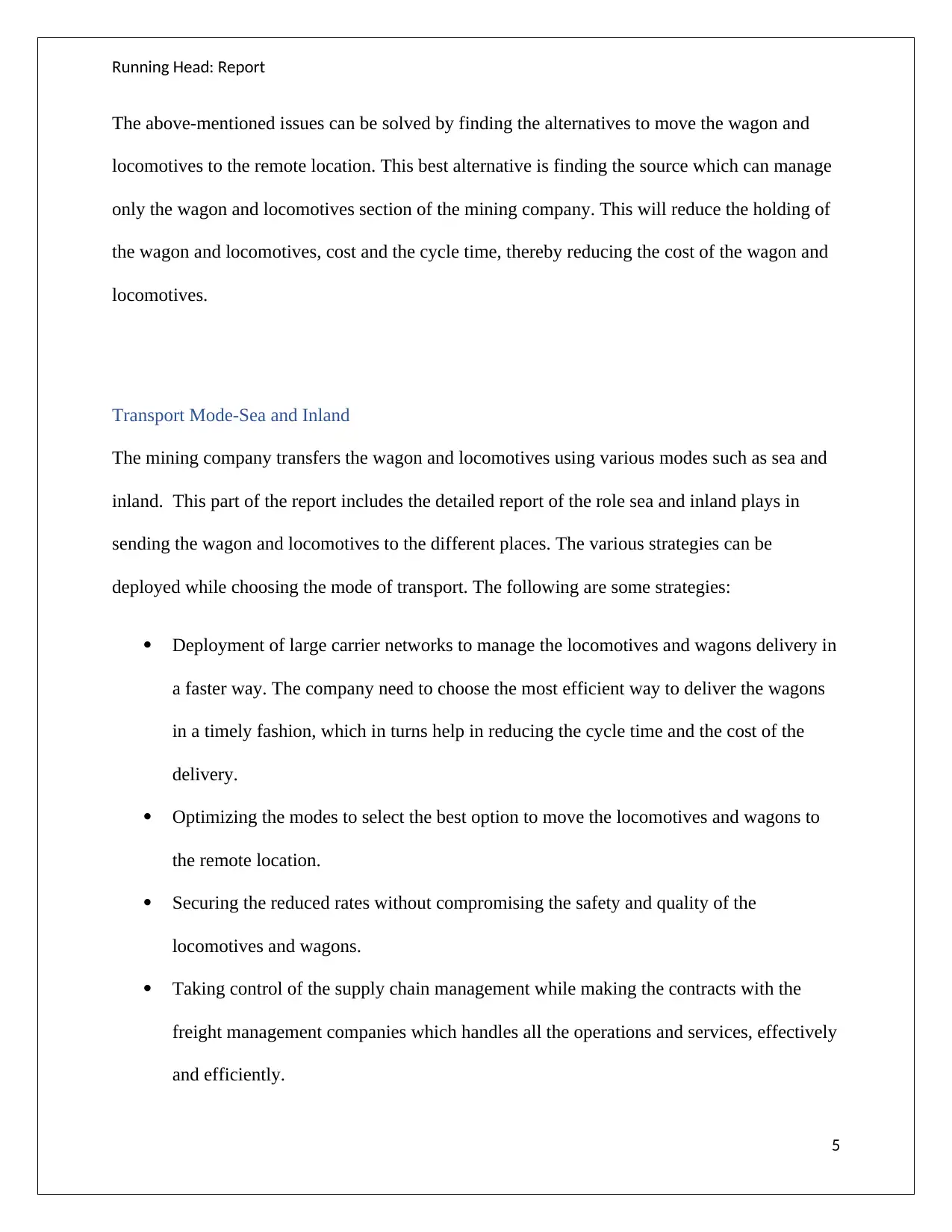
Running Head: Report
The above-mentioned issues can be solved by finding the alternatives to move the wagon and
locomotives to the remote location. This best alternative is finding the source which can manage
only the wagon and locomotives section of the mining company. This will reduce the holding of
the wagon and locomotives, cost and the cycle time, thereby reducing the cost of the wagon and
locomotives.
Transport Mode-Sea and Inland
The mining company transfers the wagon and locomotives using various modes such as sea and
inland. This part of the report includes the detailed report of the role sea and inland plays in
sending the wagon and locomotives to the different places. The various strategies can be
deployed while choosing the mode of transport. The following are some strategies:
Deployment of large carrier networks to manage the locomotives and wagons delivery in
a faster way. The company need to choose the most efficient way to deliver the wagons
in a timely fashion, which in turns help in reducing the cycle time and the cost of the
delivery.
Optimizing the modes to select the best option to move the locomotives and wagons to
the remote location.
Securing the reduced rates without compromising the safety and quality of the
locomotives and wagons.
Taking control of the supply chain management while making the contracts with the
freight management companies which handles all the operations and services, effectively
and efficiently.
5
The above-mentioned issues can be solved by finding the alternatives to move the wagon and
locomotives to the remote location. This best alternative is finding the source which can manage
only the wagon and locomotives section of the mining company. This will reduce the holding of
the wagon and locomotives, cost and the cycle time, thereby reducing the cost of the wagon and
locomotives.
Transport Mode-Sea and Inland
The mining company transfers the wagon and locomotives using various modes such as sea and
inland. This part of the report includes the detailed report of the role sea and inland plays in
sending the wagon and locomotives to the different places. The various strategies can be
deployed while choosing the mode of transport. The following are some strategies:
Deployment of large carrier networks to manage the locomotives and wagons delivery in
a faster way. The company need to choose the most efficient way to deliver the wagons
in a timely fashion, which in turns help in reducing the cycle time and the cost of the
delivery.
Optimizing the modes to select the best option to move the locomotives and wagons to
the remote location.
Securing the reduced rates without compromising the safety and quality of the
locomotives and wagons.
Taking control of the supply chain management while making the contracts with the
freight management companies which handles all the operations and services, effectively
and efficiently.
5
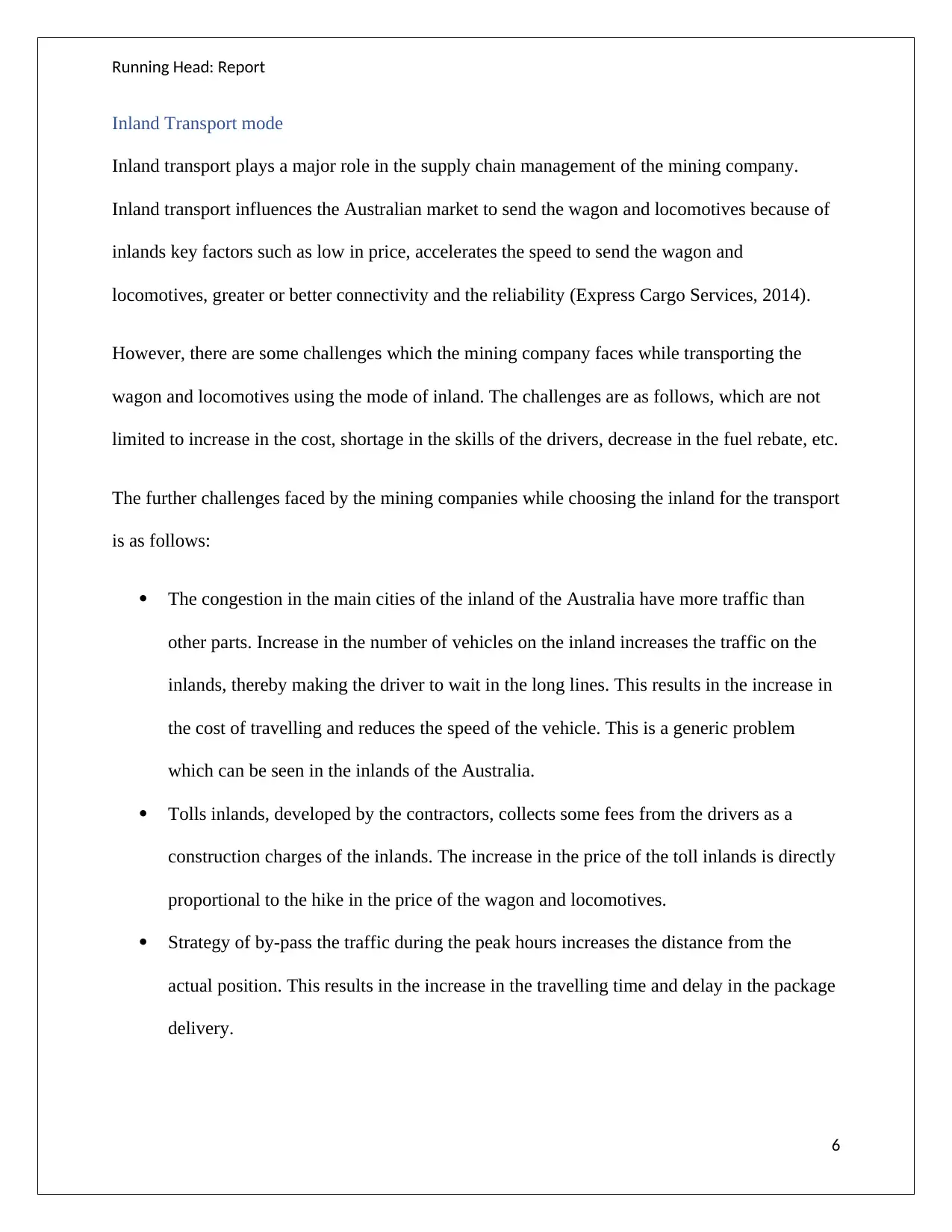
Running Head: Report
Inland Transport mode
Inland transport plays a major role in the supply chain management of the mining company.
Inland transport influences the Australian market to send the wagon and locomotives because of
inlands key factors such as low in price, accelerates the speed to send the wagon and
locomotives, greater or better connectivity and the reliability (Express Cargo Services, 2014).
However, there are some challenges which the mining company faces while transporting the
wagon and locomotives using the mode of inland. The challenges are as follows, which are not
limited to increase in the cost, shortage in the skills of the drivers, decrease in the fuel rebate, etc.
The further challenges faced by the mining companies while choosing the inland for the transport
is as follows:
The congestion in the main cities of the inland of the Australia have more traffic than
other parts. Increase in the number of vehicles on the inland increases the traffic on the
inlands, thereby making the driver to wait in the long lines. This results in the increase in
the cost of travelling and reduces the speed of the vehicle. This is a generic problem
which can be seen in the inlands of the Australia.
Tolls inlands, developed by the contractors, collects some fees from the drivers as a
construction charges of the inlands. The increase in the price of the toll inlands is directly
proportional to the hike in the price of the wagon and locomotives.
Strategy of by-pass the traffic during the peak hours increases the distance from the
actual position. This results in the increase in the travelling time and delay in the package
delivery.
6
Inland Transport mode
Inland transport plays a major role in the supply chain management of the mining company.
Inland transport influences the Australian market to send the wagon and locomotives because of
inlands key factors such as low in price, accelerates the speed to send the wagon and
locomotives, greater or better connectivity and the reliability (Express Cargo Services, 2014).
However, there are some challenges which the mining company faces while transporting the
wagon and locomotives using the mode of inland. The challenges are as follows, which are not
limited to increase in the cost, shortage in the skills of the drivers, decrease in the fuel rebate, etc.
The further challenges faced by the mining companies while choosing the inland for the transport
is as follows:
The congestion in the main cities of the inland of the Australia have more traffic than
other parts. Increase in the number of vehicles on the inland increases the traffic on the
inlands, thereby making the driver to wait in the long lines. This results in the increase in
the cost of travelling and reduces the speed of the vehicle. This is a generic problem
which can be seen in the inlands of the Australia.
Tolls inlands, developed by the contractors, collects some fees from the drivers as a
construction charges of the inlands. The increase in the price of the toll inlands is directly
proportional to the hike in the price of the wagon and locomotives.
Strategy of by-pass the traffic during the peak hours increases the distance from the
actual position. This results in the increase in the travelling time and delay in the package
delivery.
6
Paraphrase This Document
Need a fresh take? Get an instant paraphrase of this document with our AI Paraphraser
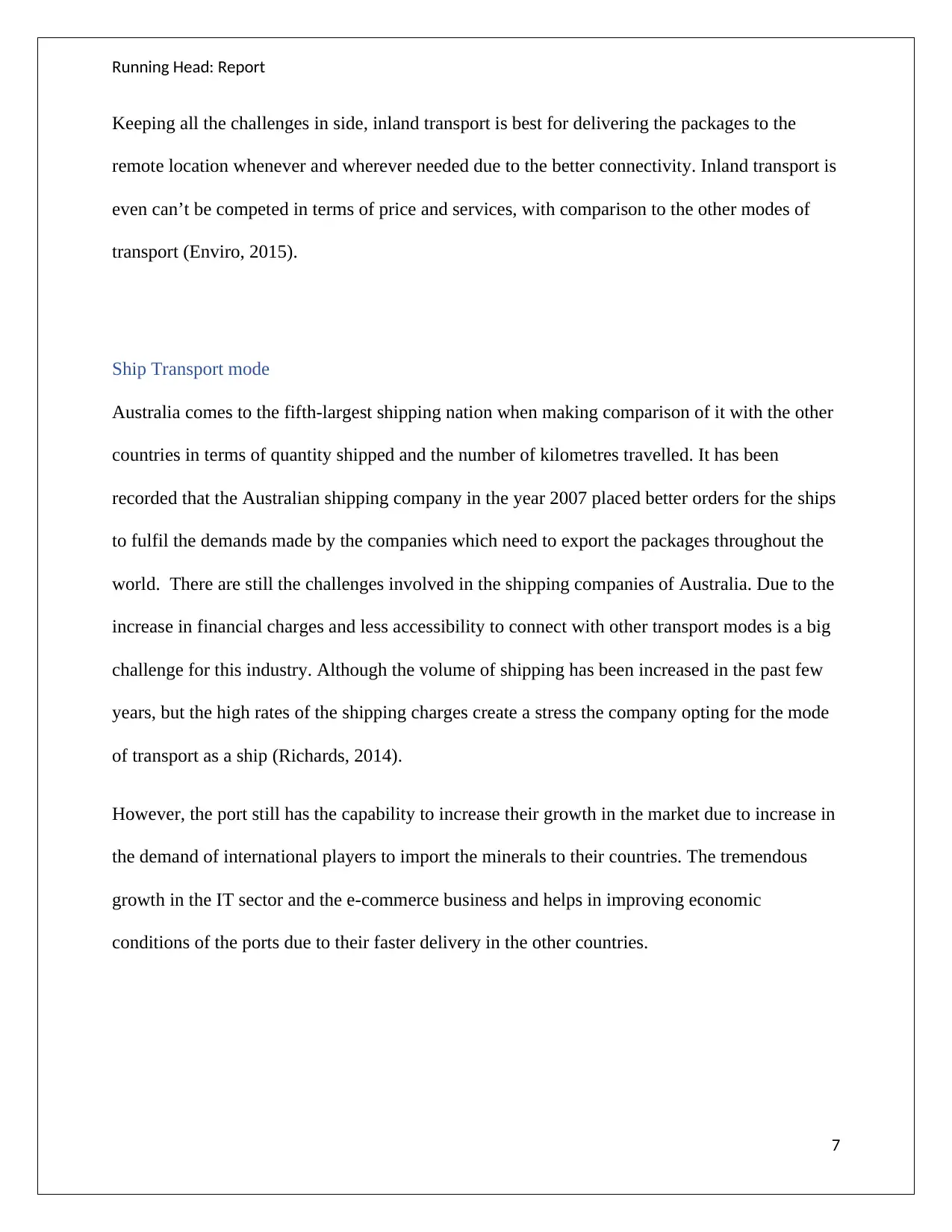
Running Head: Report
Keeping all the challenges in side, inland transport is best for delivering the packages to the
remote location whenever and wherever needed due to the better connectivity. Inland transport is
even can’t be competed in terms of price and services, with comparison to the other modes of
transport (Enviro, 2015).
Ship Transport mode
Australia comes to the fifth-largest shipping nation when making comparison of it with the other
countries in terms of quantity shipped and the number of kilometres travelled. It has been
recorded that the Australian shipping company in the year 2007 placed better orders for the ships
to fulfil the demands made by the companies which need to export the packages throughout the
world. There are still the challenges involved in the shipping companies of Australia. Due to the
increase in financial charges and less accessibility to connect with other transport modes is a big
challenge for this industry. Although the volume of shipping has been increased in the past few
years, but the high rates of the shipping charges create a stress the company opting for the mode
of transport as a ship (Richards, 2014).
However, the port still has the capability to increase their growth in the market due to increase in
the demand of international players to import the minerals to their countries. The tremendous
growth in the IT sector and the e-commerce business and helps in improving economic
conditions of the ports due to their faster delivery in the other countries.
7
Keeping all the challenges in side, inland transport is best for delivering the packages to the
remote location whenever and wherever needed due to the better connectivity. Inland transport is
even can’t be competed in terms of price and services, with comparison to the other modes of
transport (Enviro, 2015).
Ship Transport mode
Australia comes to the fifth-largest shipping nation when making comparison of it with the other
countries in terms of quantity shipped and the number of kilometres travelled. It has been
recorded that the Australian shipping company in the year 2007 placed better orders for the ships
to fulfil the demands made by the companies which need to export the packages throughout the
world. There are still the challenges involved in the shipping companies of Australia. Due to the
increase in financial charges and less accessibility to connect with other transport modes is a big
challenge for this industry. Although the volume of shipping has been increased in the past few
years, but the high rates of the shipping charges create a stress the company opting for the mode
of transport as a ship (Richards, 2014).
However, the port still has the capability to increase their growth in the market due to increase in
the demand of international players to import the minerals to their countries. The tremendous
growth in the IT sector and the e-commerce business and helps in improving economic
conditions of the ports due to their faster delivery in the other countries.
7
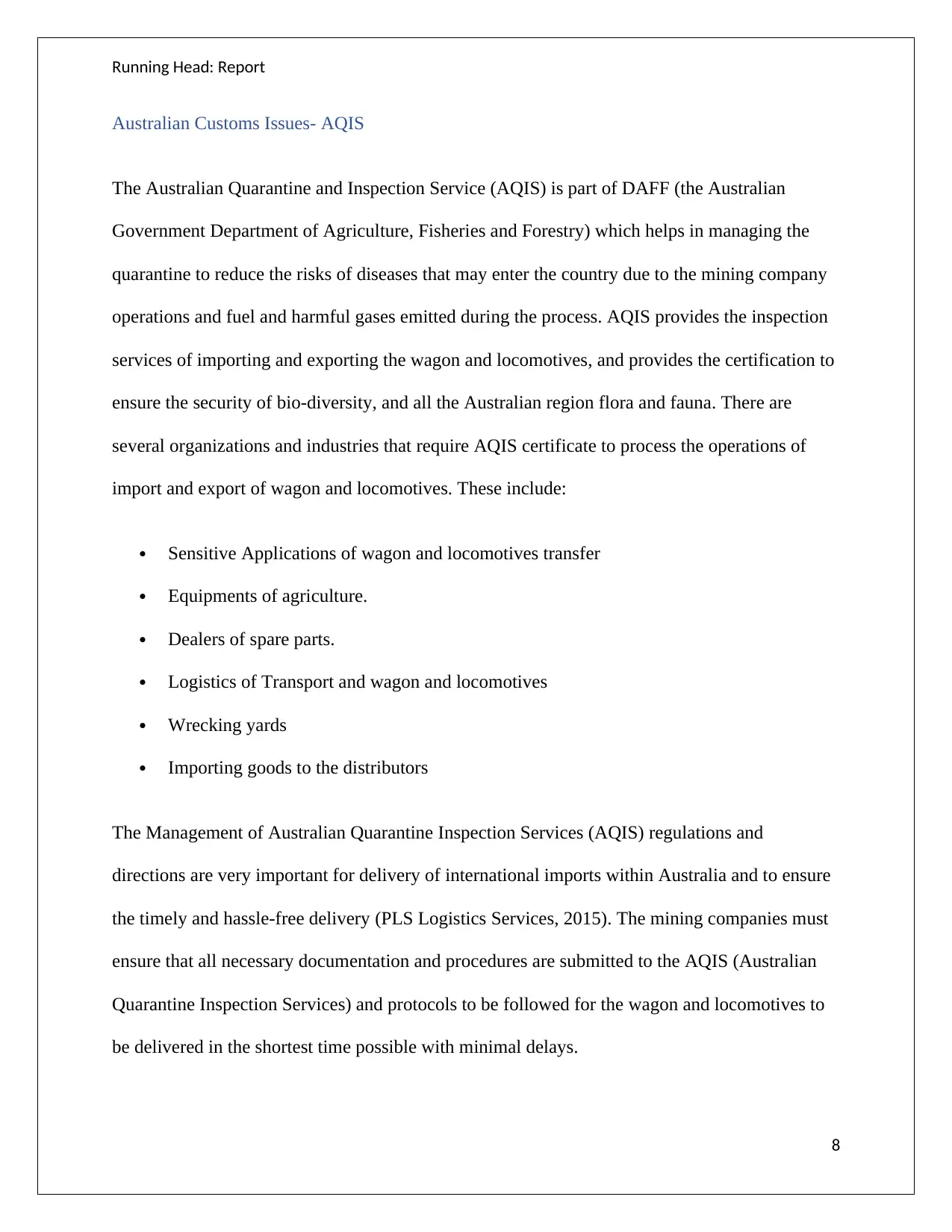
Running Head: Report
Australian Customs Issues- AQIS
The Australian Quarantine and Inspection Service (AQIS) is part of DAFF (the Australian
Government Department of Agriculture, Fisheries and Forestry) which helps in managing the
quarantine to reduce the risks of diseases that may enter the country due to the mining company
operations and fuel and harmful gases emitted during the process. AQIS provides the inspection
services of importing and exporting the wagon and locomotives, and provides the certification to
ensure the security of bio-diversity, and all the Australian region flora and fauna. There are
several organizations and industries that require AQIS certificate to process the operations of
import and export of wagon and locomotives. These include:
Sensitive Applications of wagon and locomotives transfer
Equipments of agriculture.
Dealers of spare parts.
Logistics of Transport and wagon and locomotives
Wrecking yards
Importing goods to the distributors
The Management of Australian Quarantine Inspection Services (AQIS) regulations and
directions are very important for delivery of international imports within Australia and to ensure
the timely and hassle-free delivery (PLS Logistics Services, 2015). The mining companies must
ensure that all necessary documentation and procedures are submitted to the AQIS (Australian
Quarantine Inspection Services) and protocols to be followed for the wagon and locomotives to
be delivered in the shortest time possible with minimal delays.
8
Australian Customs Issues- AQIS
The Australian Quarantine and Inspection Service (AQIS) is part of DAFF (the Australian
Government Department of Agriculture, Fisheries and Forestry) which helps in managing the
quarantine to reduce the risks of diseases that may enter the country due to the mining company
operations and fuel and harmful gases emitted during the process. AQIS provides the inspection
services of importing and exporting the wagon and locomotives, and provides the certification to
ensure the security of bio-diversity, and all the Australian region flora and fauna. There are
several organizations and industries that require AQIS certificate to process the operations of
import and export of wagon and locomotives. These include:
Sensitive Applications of wagon and locomotives transfer
Equipments of agriculture.
Dealers of spare parts.
Logistics of Transport and wagon and locomotives
Wrecking yards
Importing goods to the distributors
The Management of Australian Quarantine Inspection Services (AQIS) regulations and
directions are very important for delivery of international imports within Australia and to ensure
the timely and hassle-free delivery (PLS Logistics Services, 2015). The mining companies must
ensure that all necessary documentation and procedures are submitted to the AQIS (Australian
Quarantine Inspection Services) and protocols to be followed for the wagon and locomotives to
be delivered in the shortest time possible with minimal delays.
8
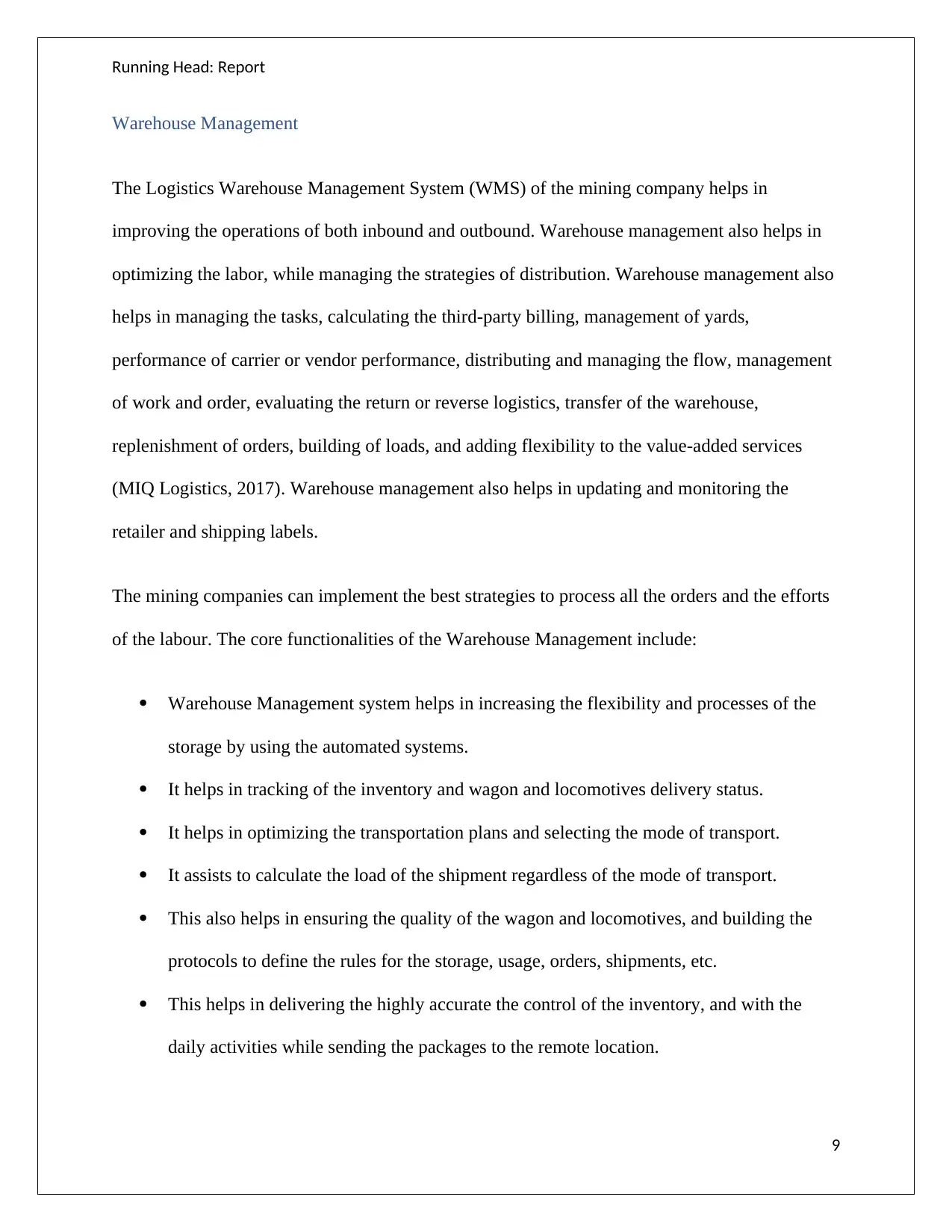
Running Head: Report
Warehouse Management
The Logistics Warehouse Management System (WMS) of the mining company helps in
improving the operations of both inbound and outbound. Warehouse management also helps in
optimizing the labor, while managing the strategies of distribution. Warehouse management also
helps in managing the tasks, calculating the third-party billing, management of yards,
performance of carrier or vendor performance, distributing and managing the flow, management
of work and order, evaluating the return or reverse logistics, transfer of the warehouse,
replenishment of orders, building of loads, and adding flexibility to the value-added services
(MIQ Logistics, 2017). Warehouse management also helps in updating and monitoring the
retailer and shipping labels.
The mining companies can implement the best strategies to process all the orders and the efforts
of the labour. The core functionalities of the Warehouse Management include:
Warehouse Management system helps in increasing the flexibility and processes of the
storage by using the automated systems.
It helps in tracking of the inventory and wagon and locomotives delivery status.
It helps in optimizing the transportation plans and selecting the mode of transport.
It assists to calculate the load of the shipment regardless of the mode of transport.
This also helps in ensuring the quality of the wagon and locomotives, and building the
protocols to define the rules for the storage, usage, orders, shipments, etc.
This helps in delivering the highly accurate the control of the inventory, and with the
daily activities while sending the packages to the remote location.
9
Warehouse Management
The Logistics Warehouse Management System (WMS) of the mining company helps in
improving the operations of both inbound and outbound. Warehouse management also helps in
optimizing the labor, while managing the strategies of distribution. Warehouse management also
helps in managing the tasks, calculating the third-party billing, management of yards,
performance of carrier or vendor performance, distributing and managing the flow, management
of work and order, evaluating the return or reverse logistics, transfer of the warehouse,
replenishment of orders, building of loads, and adding flexibility to the value-added services
(MIQ Logistics, 2017). Warehouse management also helps in updating and monitoring the
retailer and shipping labels.
The mining companies can implement the best strategies to process all the orders and the efforts
of the labour. The core functionalities of the Warehouse Management include:
Warehouse Management system helps in increasing the flexibility and processes of the
storage by using the automated systems.
It helps in tracking of the inventory and wagon and locomotives delivery status.
It helps in optimizing the transportation plans and selecting the mode of transport.
It assists to calculate the load of the shipment regardless of the mode of transport.
This also helps in ensuring the quality of the wagon and locomotives, and building the
protocols to define the rules for the storage, usage, orders, shipments, etc.
This helps in delivering the highly accurate the control of the inventory, and with the
daily activities while sending the packages to the remote location.
9
Secure Best Marks with AI Grader
Need help grading? Try our AI Grader for instant feedback on your assignments.
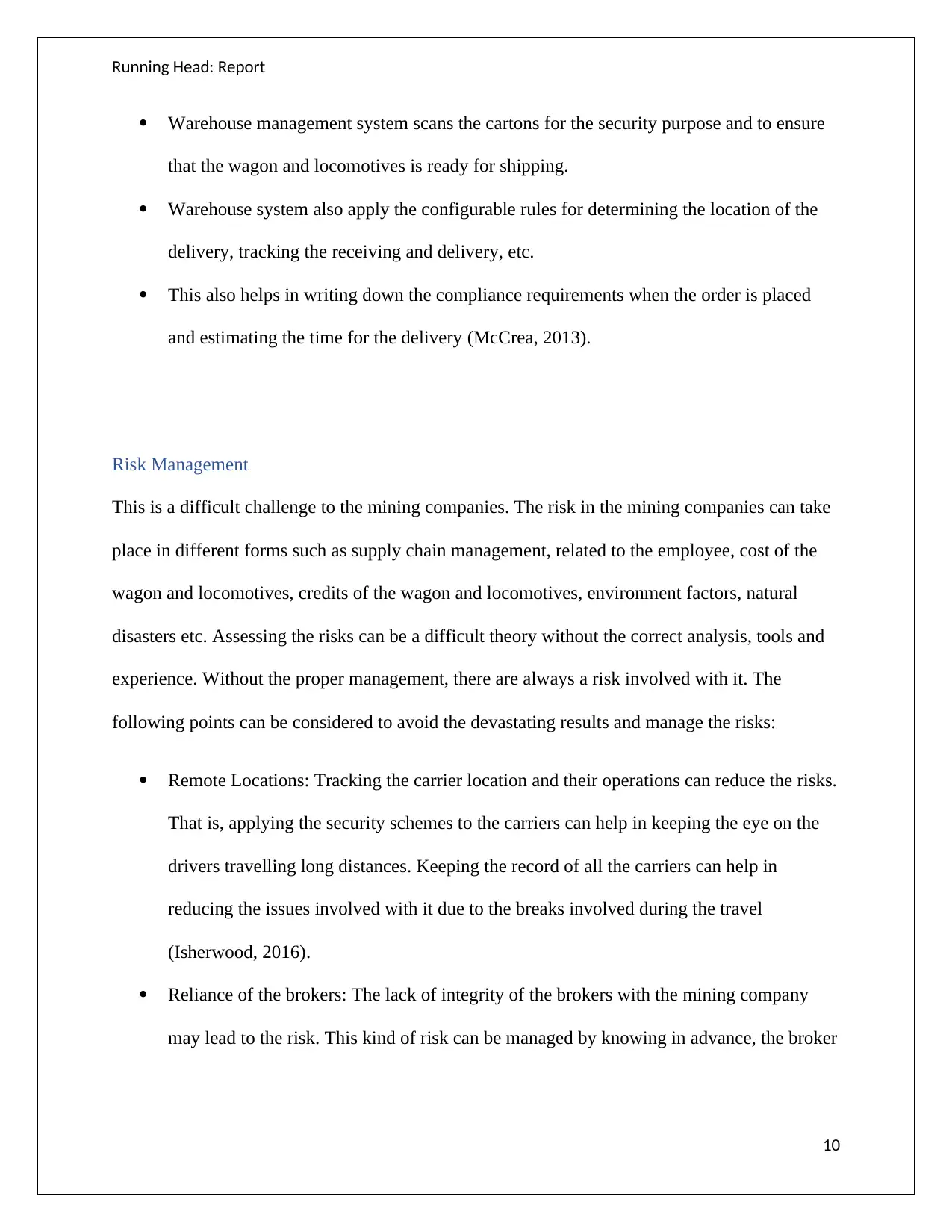
Running Head: Report
Warehouse management system scans the cartons for the security purpose and to ensure
that the wagon and locomotives is ready for shipping.
Warehouse system also apply the configurable rules for determining the location of the
delivery, tracking the receiving and delivery, etc.
This also helps in writing down the compliance requirements when the order is placed
and estimating the time for the delivery (McCrea, 2013).
Risk Management
This is a difficult challenge to the mining companies. The risk in the mining companies can take
place in different forms such as supply chain management, related to the employee, cost of the
wagon and locomotives, credits of the wagon and locomotives, environment factors, natural
disasters etc. Assessing the risks can be a difficult theory without the correct analysis, tools and
experience. Without the proper management, there are always a risk involved with it. The
following points can be considered to avoid the devastating results and manage the risks:
Remote Locations: Tracking the carrier location and their operations can reduce the risks.
That is, applying the security schemes to the carriers can help in keeping the eye on the
drivers travelling long distances. Keeping the record of all the carriers can help in
reducing the issues involved with it due to the breaks involved during the travel
(Isherwood, 2016).
Reliance of the brokers: The lack of integrity of the brokers with the mining company
may lead to the risk. This kind of risk can be managed by knowing in advance, the broker
10
Warehouse management system scans the cartons for the security purpose and to ensure
that the wagon and locomotives is ready for shipping.
Warehouse system also apply the configurable rules for determining the location of the
delivery, tracking the receiving and delivery, etc.
This also helps in writing down the compliance requirements when the order is placed
and estimating the time for the delivery (McCrea, 2013).
Risk Management
This is a difficult challenge to the mining companies. The risk in the mining companies can take
place in different forms such as supply chain management, related to the employee, cost of the
wagon and locomotives, credits of the wagon and locomotives, environment factors, natural
disasters etc. Assessing the risks can be a difficult theory without the correct analysis, tools and
experience. Without the proper management, there are always a risk involved with it. The
following points can be considered to avoid the devastating results and manage the risks:
Remote Locations: Tracking the carrier location and their operations can reduce the risks.
That is, applying the security schemes to the carriers can help in keeping the eye on the
drivers travelling long distances. Keeping the record of all the carriers can help in
reducing the issues involved with it due to the breaks involved during the travel
(Isherwood, 2016).
Reliance of the brokers: The lack of integrity of the brokers with the mining company
may lead to the risk. This kind of risk can be managed by knowing in advance, the broker
10
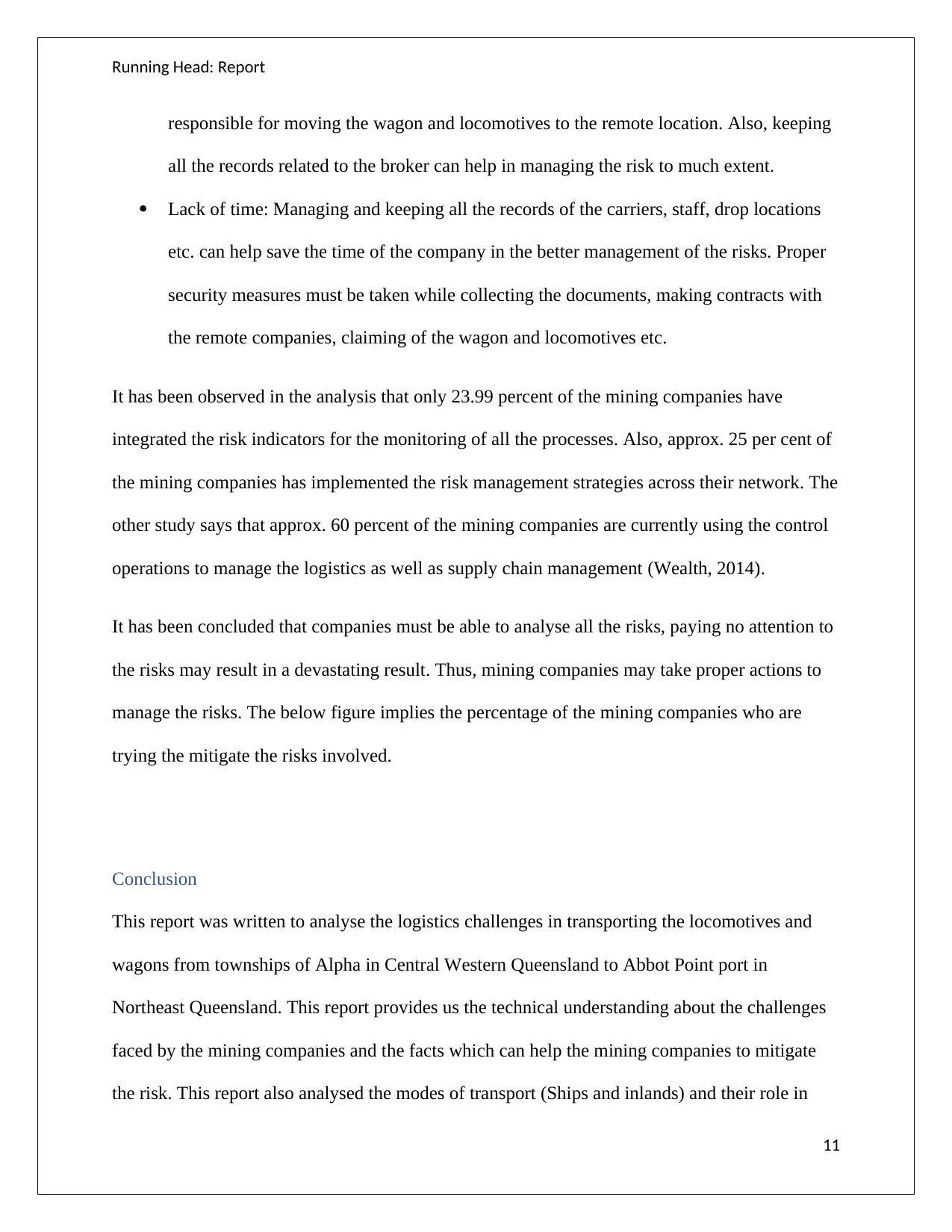
Running Head: Report
responsible for moving the wagon and locomotives to the remote location. Also, keeping
all the records related to the broker can help in managing the risk to much extent.
Lack of time: Managing and keeping all the records of the carriers, staff, drop locations
etc. can help save the time of the company in the better management of the risks. Proper
security measures must be taken while collecting the documents, making contracts with
the remote companies, claiming of the wagon and locomotives etc.
It has been observed in the analysis that only 23.99 percent of the mining companies have
integrated the risk indicators for the monitoring of all the processes. Also, approx. 25 per cent of
the mining companies has implemented the risk management strategies across their network. The
other study says that approx. 60 percent of the mining companies are currently using the control
operations to manage the logistics as well as supply chain management (Wealth, 2014).
It has been concluded that companies must be able to analyse all the risks, paying no attention to
the risks may result in a devastating result. Thus, mining companies may take proper actions to
manage the risks. The below figure implies the percentage of the mining companies who are
trying the mitigate the risks involved.
Conclusion
This report was written to analyse the logistics challenges in transporting the locomotives and
wagons from townships of Alpha in Central Western Queensland to Abbot Point port in
Northeast Queensland. This report provides us the technical understanding about the challenges
faced by the mining companies and the facts which can help the mining companies to mitigate
the risk. This report also analysed the modes of transport (Ships and inlands) and their role in
11
responsible for moving the wagon and locomotives to the remote location. Also, keeping
all the records related to the broker can help in managing the risk to much extent.
Lack of time: Managing and keeping all the records of the carriers, staff, drop locations
etc. can help save the time of the company in the better management of the risks. Proper
security measures must be taken while collecting the documents, making contracts with
the remote companies, claiming of the wagon and locomotives etc.
It has been observed in the analysis that only 23.99 percent of the mining companies have
integrated the risk indicators for the monitoring of all the processes. Also, approx. 25 per cent of
the mining companies has implemented the risk management strategies across their network. The
other study says that approx. 60 percent of the mining companies are currently using the control
operations to manage the logistics as well as supply chain management (Wealth, 2014).
It has been concluded that companies must be able to analyse all the risks, paying no attention to
the risks may result in a devastating result. Thus, mining companies may take proper actions to
manage the risks. The below figure implies the percentage of the mining companies who are
trying the mitigate the risks involved.
Conclusion
This report was written to analyse the logistics challenges in transporting the locomotives and
wagons from townships of Alpha in Central Western Queensland to Abbot Point port in
Northeast Queensland. This report provides us the technical understanding about the challenges
faced by the mining companies and the facts which can help the mining companies to mitigate
the risk. This report also analysed the modes of transport (Ships and inlands) and their role in
11
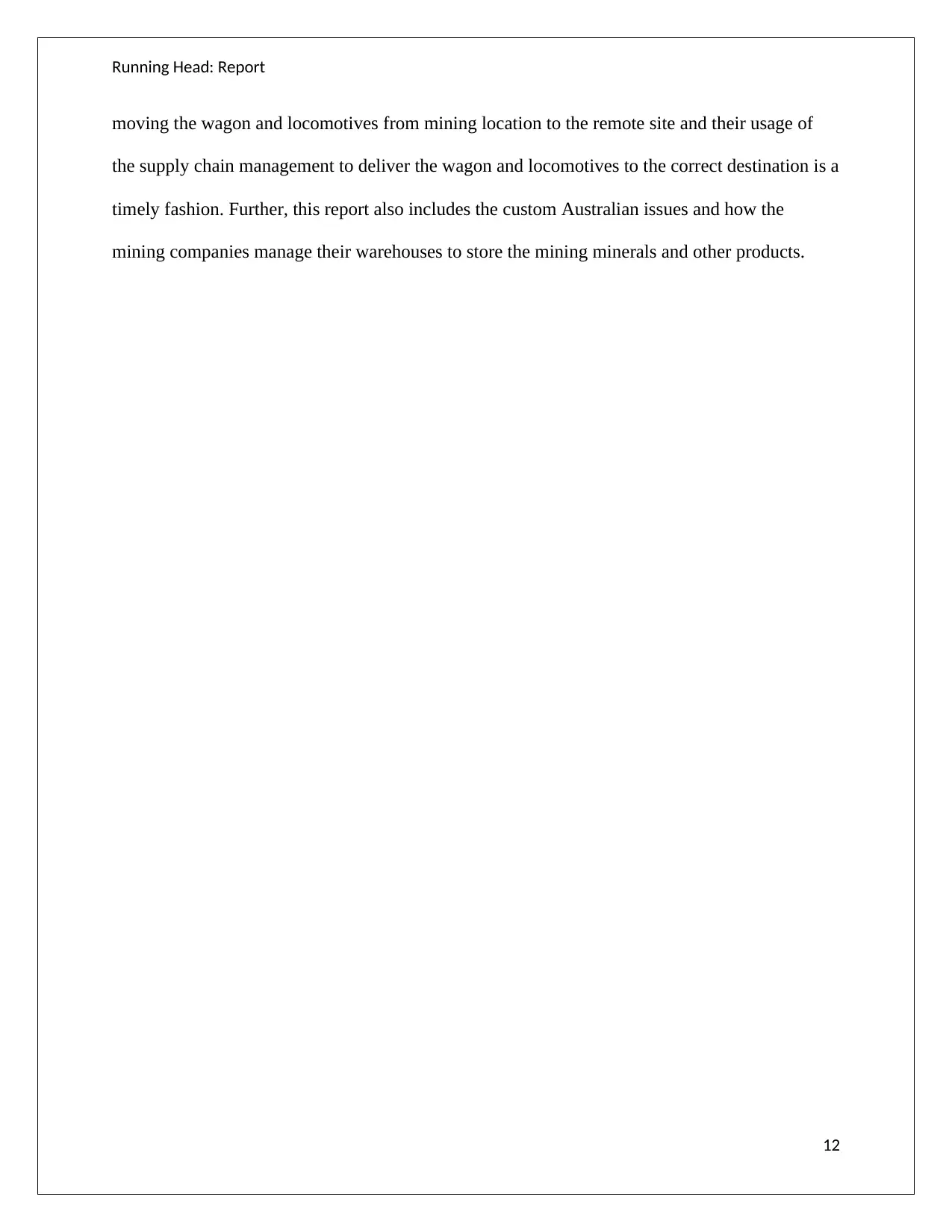
Running Head: Report
moving the wagon and locomotives from mining location to the remote site and their usage of
the supply chain management to deliver the wagon and locomotives to the correct destination is a
timely fashion. Further, this report also includes the custom Australian issues and how the
mining companies manage their warehouses to store the mining minerals and other products.
12
moving the wagon and locomotives from mining location to the remote site and their usage of
the supply chain management to deliver the wagon and locomotives to the correct destination is a
timely fashion. Further, this report also includes the custom Australian issues and how the
mining companies manage their warehouses to store the mining minerals and other products.
12
Paraphrase This Document
Need a fresh take? Get an instant paraphrase of this document with our AI Paraphraser
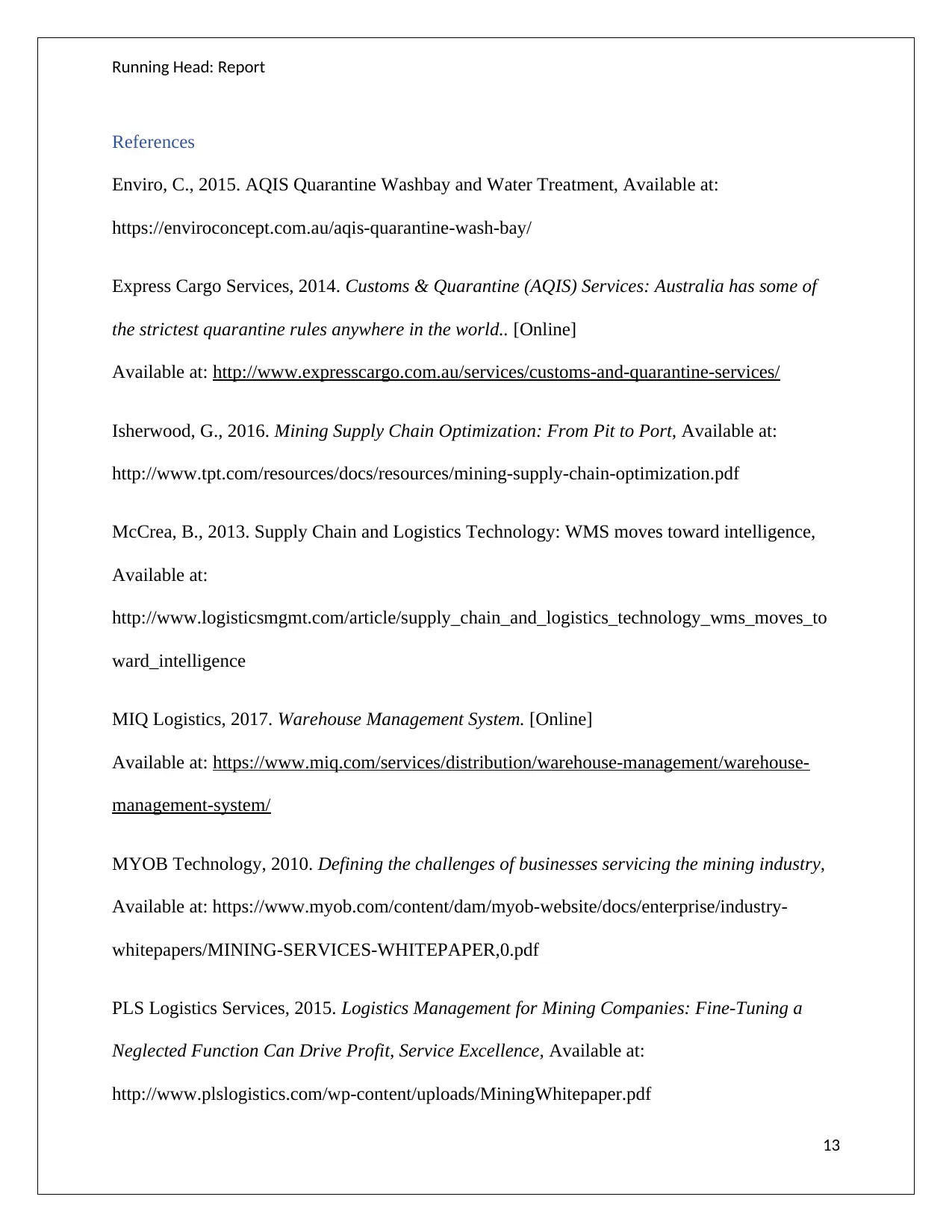
Running Head: Report
References
Enviro, C., 2015. AQIS Quarantine Washbay and Water Treatment, Available at:
https://enviroconcept.com.au/aqis-quarantine-wash-bay/
Express Cargo Services, 2014. Customs & Quarantine (AQIS) Services: Australia has some of
the strictest quarantine rules anywhere in the world.. [Online]
Available at: http://www.expresscargo.com.au/services/customs-and-quarantine-services/
Isherwood, G., 2016. Mining Supply Chain Optimization: From Pit to Port, Available at:
http://www.tpt.com/resources/docs/resources/mining-supply-chain-optimization.pdf
McCrea, B., 2013. Supply Chain and Logistics Technology: WMS moves toward intelligence,
Available at:
http://www.logisticsmgmt.com/article/supply_chain_and_logistics_technology_wms_moves_to
ward_intelligence
MIQ Logistics, 2017. Warehouse Management System. [Online]
Available at: https://www.miq.com/services/distribution/warehouse-management/warehouse-
management-system/
MYOB Technology, 2010. Defining the challenges of businesses servicing the mining industry,
Available at: https://www.myob.com/content/dam/myob-website/docs/enterprise/industry-
whitepapers/MINING-SERVICES-WHITEPAPER,0.pdf
PLS Logistics Services, 2015. Logistics Management for Mining Companies: Fine-Tuning a
Neglected Function Can Drive Profit, Service Excellence, Available at:
http://www.plslogistics.com/wp-content/uploads/MiningWhitepaper.pdf
13
References
Enviro, C., 2015. AQIS Quarantine Washbay and Water Treatment, Available at:
https://enviroconcept.com.au/aqis-quarantine-wash-bay/
Express Cargo Services, 2014. Customs & Quarantine (AQIS) Services: Australia has some of
the strictest quarantine rules anywhere in the world.. [Online]
Available at: http://www.expresscargo.com.au/services/customs-and-quarantine-services/
Isherwood, G., 2016. Mining Supply Chain Optimization: From Pit to Port, Available at:
http://www.tpt.com/resources/docs/resources/mining-supply-chain-optimization.pdf
McCrea, B., 2013. Supply Chain and Logistics Technology: WMS moves toward intelligence,
Available at:
http://www.logisticsmgmt.com/article/supply_chain_and_logistics_technology_wms_moves_to
ward_intelligence
MIQ Logistics, 2017. Warehouse Management System. [Online]
Available at: https://www.miq.com/services/distribution/warehouse-management/warehouse-
management-system/
MYOB Technology, 2010. Defining the challenges of businesses servicing the mining industry,
Available at: https://www.myob.com/content/dam/myob-website/docs/enterprise/industry-
whitepapers/MINING-SERVICES-WHITEPAPER,0.pdf
PLS Logistics Services, 2015. Logistics Management for Mining Companies: Fine-Tuning a
Neglected Function Can Drive Profit, Service Excellence, Available at:
http://www.plslogistics.com/wp-content/uploads/MiningWhitepaper.pdf
13
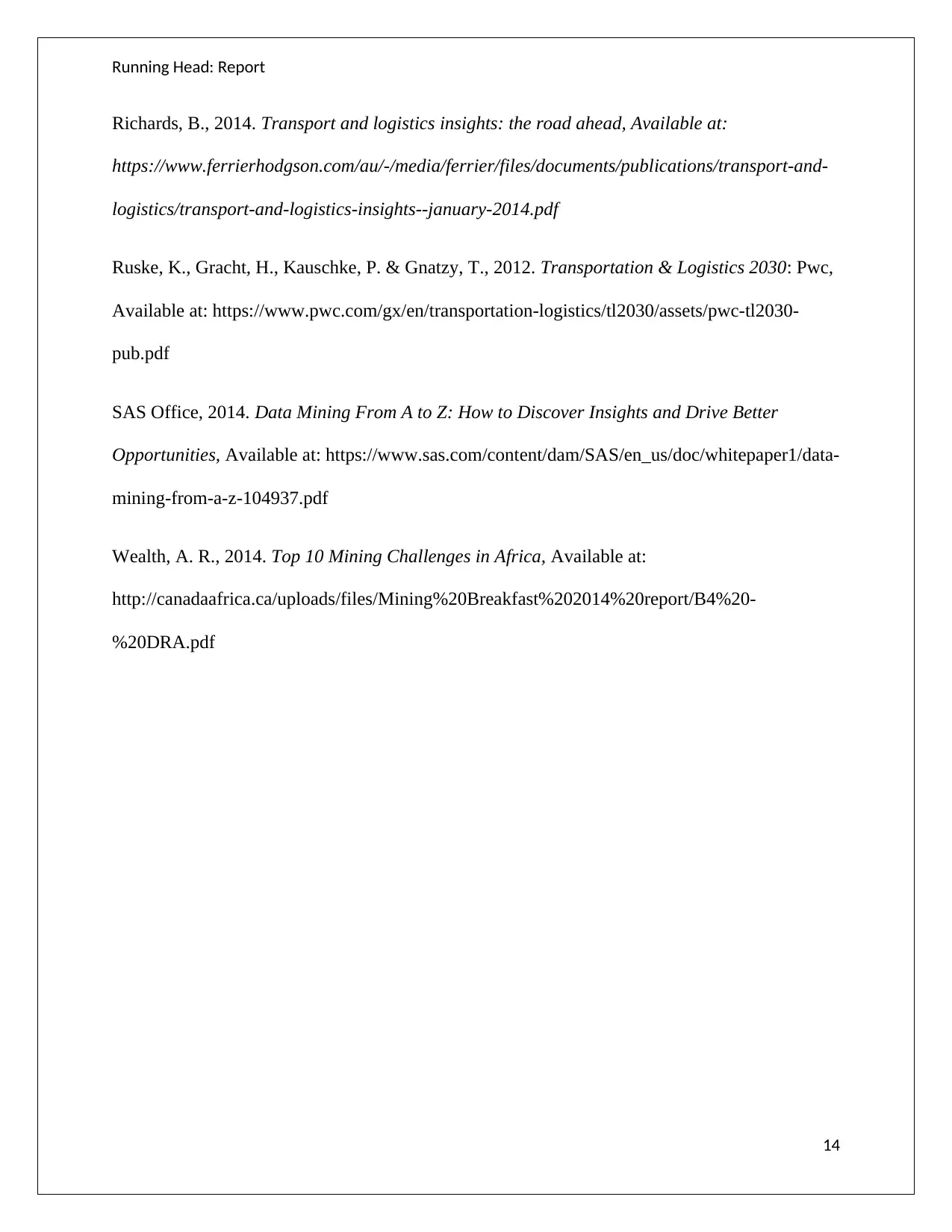
Running Head: Report
Richards, B., 2014. Transport and logistics insights: the road ahead, Available at:
https://www.ferrierhodgson.com/au/-/media/ferrier/files/documents/publications/transport-and-
logistics/transport-and-logistics-insights--january-2014.pdf
Ruske, K., Gracht, H., Kauschke, P. & Gnatzy, T., 2012. Transportation & Logistics 2030: Pwc,
Available at: https://www.pwc.com/gx/en/transportation-logistics/tl2030/assets/pwc-tl2030-
pub.pdf
SAS Office, 2014. Data Mining From A to Z: How to Discover Insights and Drive Better
Opportunities, Available at: https://www.sas.com/content/dam/SAS/en_us/doc/whitepaper1/data-
mining-from-a-z-104937.pdf
Wealth, A. R., 2014. Top 10 Mining Challenges in Africa, Available at:
http://canadaafrica.ca/uploads/files/Mining%20Breakfast%202014%20report/B4%20-
%20DRA.pdf
14
Richards, B., 2014. Transport and logistics insights: the road ahead, Available at:
https://www.ferrierhodgson.com/au/-/media/ferrier/files/documents/publications/transport-and-
logistics/transport-and-logistics-insights--january-2014.pdf
Ruske, K., Gracht, H., Kauschke, P. & Gnatzy, T., 2012. Transportation & Logistics 2030: Pwc,
Available at: https://www.pwc.com/gx/en/transportation-logistics/tl2030/assets/pwc-tl2030-
pub.pdf
SAS Office, 2014. Data Mining From A to Z: How to Discover Insights and Drive Better
Opportunities, Available at: https://www.sas.com/content/dam/SAS/en_us/doc/whitepaper1/data-
mining-from-a-z-104937.pdf
Wealth, A. R., 2014. Top 10 Mining Challenges in Africa, Available at:
http://canadaafrica.ca/uploads/files/Mining%20Breakfast%202014%20report/B4%20-
%20DRA.pdf
14
1 out of 15
Related Documents
Your All-in-One AI-Powered Toolkit for Academic Success.
+13062052269
info@desklib.com
Available 24*7 on WhatsApp / Email
![[object Object]](/_next/static/media/star-bottom.7253800d.svg)
Unlock your academic potential
© 2024 | Zucol Services PVT LTD | All rights reserved.





